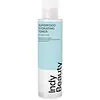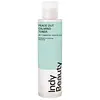What's inside
What's inside
 Key Ingredients
Key Ingredients

 Benefits
Benefits

 Concerns
Concerns

 Ingredients Side-by-side
Ingredients Side-by-side

Water
Skin ConditioningPropanediol
SolventPolysorbate 20
EmulsifyingPolyglutamic Acid
Skin ConditioningChamomilla Recutita Flower Extract
MaskingBetaine
HumectantXylitylglucoside
HumectantXylitol
HumectantPanthenol
Skin ConditioningAnhydroxylitol
HumectantHydroxyethylcellulose
Emulsion StabilisingAlpha-Glucan Oligosaccharide
CleansingButylene Glycol
HumectantEthylhexylglycerin
Skin ConditioningGlucose
HumectantCitric Acid
BufferingPantolactone
HumectantCamellia Sinensis Leaf Extract
AntimicrobialCentella Asiatica Extract
CleansingInonotus Obliquus Extract
Skin ConditioningEleutherococcus Senticosus Root Extract
AstringentGlycyrrhiza Glabra Root Extract
BleachingPolygonum Cuspidatum Root Extract
AntioxidantRhaponticum Carthamoides Root Extract
Skin ConditioningRhodiola Rosea Extract
EmollientRosmarinus Officinalis Leaf Extract
AntimicrobialScutellaria Baicalensis Root Extract
AstringentSelaginella Lepidophylla Extract
EmollientSodium Benzoate
MaskingMaltodextrin
AbsorbentLactic Acid
BufferingCaramel
Cosmetic ColorantPhenoxyethanol
PreservativeWater, Propanediol, Polysorbate 20, Polyglutamic Acid, Chamomilla Recutita Flower Extract, Betaine, Xylitylglucoside, Xylitol, Panthenol, Anhydroxylitol, Hydroxyethylcellulose, Alpha-Glucan Oligosaccharide, Butylene Glycol, Ethylhexylglycerin, Glucose, Citric Acid, Pantolactone, Camellia Sinensis Leaf Extract, Centella Asiatica Extract, Inonotus Obliquus Extract, Eleutherococcus Senticosus Root Extract, Glycyrrhiza Glabra Root Extract, Polygonum Cuspidatum Root Extract, Rhaponticum Carthamoides Root Extract, Rhodiola Rosea Extract, Rosmarinus Officinalis Leaf Extract, Scutellaria Baicalensis Root Extract, Selaginella Lepidophylla Extract, Sodium Benzoate, Maltodextrin, Lactic Acid, Caramel, Phenoxyethanol
Water
Skin ConditioningGlycerin
HumectantC15-19 Alkane
SolventCaprylic/Capric Triglyceride
MaskingButylene Glycol
HumectantPanthenol
Skin ConditioningXanthan Gum
EmulsifyingEthylhexylglycerin
Skin ConditioningSodium Hyaluronate
HumectantBiosaccharide Gum-1
HumectantPhenoxyethanol
PreservativeCitric Acid
BufferingAvena Sativa Kernel Oil
Skin ConditioningCannabis Sativa Seed Oil
EmollientCetearyl Alcohol
EmollientGlyceryl Stearate Se
EmulsifyingPolyacrylate Crosspolymer-6
Emulsion StabilisingAllantoin
Skin ConditioningT-Butyl Alcohol
PerfumingPantolactone
HumectantCI 75810
Cosmetic ColorantWater, Glycerin, C15-19 Alkane, Caprylic/Capric Triglyceride, Butylene Glycol, Panthenol, Xanthan Gum, Ethylhexylglycerin, Sodium Hyaluronate, Biosaccharide Gum-1, Phenoxyethanol, Citric Acid, Avena Sativa Kernel Oil, Cannabis Sativa Seed Oil, Cetearyl Alcohol, Glyceryl Stearate Se, Polyacrylate Crosspolymer-6, Allantoin, T-Butyl Alcohol, Pantolactone, CI 75810
Ingredients Explained
These ingredients are found in both products.
Ingredients higher up in an ingredient list are typically present in a larger amount.
Butylene Glycol (or BG) is used within cosmetic products for a few different reasons:
Overall, Butylene Glycol is a safe and well-rounded ingredient that works well with other ingredients.
Though this ingredient works well with most skin types, some people with sensitive skin may experience a reaction such as allergic rashes, closed comedones, or itchiness.
Learn more about Butylene GlycolCitric Acid is an alpha hydroxy acid (AHA) naturally found in citrus fruits like oranges, lemons, and limes.
Like other AHAs, citric acid can exfoliate skin by breaking down the bonds that hold dead skin cells together. This helps reveal smoother and brighter skin underneath.
However, this exfoliating effect only happens at high concentrations (20%) which can be hard to find in cosmetic products.
Due to this, citric acid is usually included in small amounts as a pH adjuster. This helps keep products slightly more acidic and compatible with skin's natural pH.
In skincare formulas, citric acid can:
While it can provide some skin benefits, research shows lactic acid and glycolic acid are generally more effective and less irritating exfoliants.
Most citric acid used in skincare today is made by fermenting sugars (usually from molasses). This synthetic version is identical to the natural citrus form but easier to stabilize and use in formulations.
Read more about some other popular AHA's here:
Learn more about Citric AcidEthylhexylglycerin (we can't pronounce this either) is commonly used as a preservative and skin softener. It is derived from glyceryl.
You might see Ethylhexylglycerin often paired with other preservatives such as phenoxyethanol. Ethylhexylglycerin has been found to increase the effectiveness of these other preservatives.
Panthenol is a common ingredient that helps hydrate and soothe the skin. It is found naturally in our skin and hair.
There are two forms of panthenol: D and L.
D-panthenol is also known as dexpanthenol. Most cosmetics use dexpanthenol or a mixture of D and L-panthenol.
Panthenol is famous due to its ability to go deeper into the skin's layers. Using this ingredient has numerous pros (and no cons):
Like hyaluronic acid, panthenol is a humectant. Humectants are able to bind and hold large amounts of water to keep skin hydrated.
This ingredient works well for wound healing. It works by increasing tissue in the wound and helps close open wounds.
Once oxidized, panthenol converts to pantothenic acid. Panthothenic acid is found in all living cells.
This ingredient is also referred to as pro-vitamin B5.
Learn more about PanthenolPantolactone is a synthetically created humectant.
As a humectant, Pantolactone helps draw moisture to the skin. It can help add hydration to your skin.
Phenoxyethanol is a preservative that has germicide, antimicrobial, and aromatic properties. Studies show that phenoxyethanol can prevent microbial growth. By itself, it has a scent that is similar to that of a rose.
It's often used in formulations along with Caprylyl Glycol to preserve the shelf life of products.
Water. It's the most common cosmetic ingredient of all. You'll usually see it at the top of ingredient lists, meaning that it makes up the largest part of the product.
So why is it so popular? Water most often acts as a solvent - this means that it helps dissolve other ingredients into the formulation.
You'll also recognize water as that liquid we all need to stay alive. If you see this, drink a glass of water. Stay hydrated!
Learn more about Water